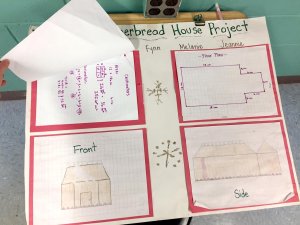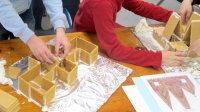The Great Gingerbread House Project
Keeping fourth graders engaged in math in the run-up to winter break is easier with this sweet project.
Your content has been saved!
Go to My Saved Content.The weeks leading up to winter break can be a challenging time to keep kids motivated at school. It can feel like you lose precious teaching time because they’re distracted and anxious for the holidays to begin. A weeklong hands-on, cumulative math project may be just what you need to keep them engaged and thinking right up to the break.
One project I love to do with fourth graders is the Great Gingerbread House Project, a mix of review and new content. It keeps kids’ minds active until the last day of the school term. The balance of old and new math works because the project is so hands on that students can see connections between previous understanding and new challenges.
Kids need a lot of motivation to do this much math during a time when they’re thinking of snow, hot chocolate, and holidays. Before we begin, we look at pictures of gingerbread houses. The students learn how they’re going to spend the next week or so in math class: designing and building their own “gingerbread” houses (for simplicity, we use graham crackers—they’re cheap and easy to get, and they have a very consistent shape and size). The kids always become really excited, and they stay excited even after they find out it’s going to take a lot of work and a lot of math to complete the project.
How the Great Gingerbread House Project Works
For this project, you’ll need to provide 1x1 cm grid paper, base 10 blocks, and graham crackers as tools for designing a floor plan that doesn’t exceed the area of six graham crackers. That’s a realistic size for the kids to work with, and helps limit the number of graham crackers you need to supply. The students can use whole, half, or quarter graham crackers. They need to find the area and perimeter of the floor plan in centimeter and graham cracker units. This gets kids working with multiplication, addition, and fractions. Some students will use the base 10 blocks to create the floor plan, but they don’t have to.
At this point in the year, some students may still be shaky when multiplying two 2-digit numbers, and often fourth graders haven’t done much work with fractions yet. The floor plan provides an authentic scenario for applying math skills they’ve been introduced to in the first few months of school. Finding area and perimeter with visuals and hands-on tools helps them grapple with new concepts, like adding fractions.
This project is not just about numbers and sweet treats—there’s also a heavy focus on craftsmanship. Students create drafts and neat, accurate final copies every step along the way. They work in pairs, but each partner is individually responsible for a draft and final copy of each step: a floor plan with labeled dimensions, the math work that shows how they found the total area and perimeter, and front- and side-view drawings of the gingerbread house they intend to build.

This project requires creativity, precise calculation, and spatial reasoning. Collaboration and compromise are necessary for partners to create a design and work accurately with numbers in the tens and hundreds—the numbers can get quite high when working in centimeters. During the project, partners help each other with math strategies and use each other to check for accuracy. They work together to record their predictions for how many graham crackers they’ll need to build the floor, walls, and roof of their house.
Once the partners complete these steps, they create a poster with four quadrants: predictions, floor plan, front view, and side view. They staple all their work in these sections with their final drafts on top so that someone can flip through and see the work they’ve done along the way. The posters are one more way to emphasize the importance of the process, not just the final product.
Finally, when partners have shown accurate math and neat craftsmanship on every part of the planning, they get to build. You’ll need to have royal icing—which is easy to make—on hand to serve as the glue. (It hardens completely, unlike regular frosting.) I ask parents to send in decorating materials—chocolate chips, mini marshmallows, Skittles, mini candy canes, etc. What comes in depends on the parents, and on student allergies. Partners carefully follow their plans to build delicious smelling graham cracker “gingerbread” houses. As they build, they keep track of how many graham crackers they actually use for the floor, walls, and roof. They record their “actuals” next to their predictions.
When the posters are complete and the houses are built, it’s fun to invite parents and classes from other grade levels to see the project. Students are proud to show off the hard work they’ve done. They like to explain the process, flipping through each of their many drafts. It’s also a good idea to provide some reflection time. Students can think back through the steps of the project, consider the challenges they faced, and reflect on how their partners helped them be successful.
For me, the Great Gingerbread House Project changed what it means to teach in December. It makes it possible for students to be motivated, engaged, and collaborating while doing lots of deep thinking and authentic math every day until winter break.
